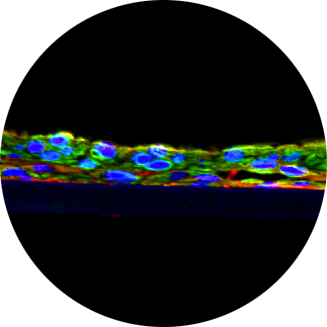Novel Organotypic Patient-Derived Primary Tumor Tissues for Oncology Drug Safety and Efficacy Studies
- TR Number: 1040
- Authors: Seyoum Ayehunie, PhD, Megan Groves,BSc, Dylan Bryda, MSc, Alex Armento, MSc, Anthony Tolcher, MD
- Materials Tested: Cisplatin, Oxaliplatin, Fluorouracil, Cetuximab
- Link to PDF: https://www.researchgate.net/publication/379217618_Abstract_221_Novel_organotypic_patient_derived_primary_tumor_tissues_for_oncology_drug_safety_and_efficacy_studies
Organotypic, three-dimensional (3D) cancer tissue models (OCTM) have enabled investigators to develop predictive markers that can be used in preclinical cancer drug development. However, a drawback of the existing models is that they are mostly cell line-based are not physiologic. In vitro development of 3D tumoroids using patient derived primary tumors (PDPT) in tumor microenvironment (TME) will have clinical significance and can predict human responses to cancer therapeutics. Here, we describe the generation of OCTM from patient-derived metastatic colon cancer, the second most deadly cancer. PDPT were grown in Matrigel for 5 passages and for biobanking purposes tumoroids were further expanded in faCellitate 384 well plates or Sun Bioscience plates to harvest large amounts of well-defined tumoroids cultured for over 21 days. Expanded tumoroids were collected and cryopreserved or gently mixed several times using a pipet tip to break up tumoroids into smaller fragments. These tumor fragments were mixed with endothelial cells, dendritic cells, fibroblasts and embedded in a collagen matrix to simulate TME. The collagen-cell mixture was then added to Transwells and induced to gel to form a collagen gel matrix that simulates TME. The tumoroids were cultured with a specialized medium that supports the growth of complex cell types. The tumor development was monitored daily using bright field microscopy and image analysis was used to monitor tumor size. To evaluate the utility of the OCTM, treatment was initiated at day 10 of the culture period by exposing tissues with cancer therapeutic drugs Cisplatin, Oxaliplatin, Fluorouracil, and Cetuximab on days 0, 2, 4, 7, 9, and 11. After each treatment, OCTM tissues (N=2) were fixed for histological analysis or used for live/dead staining. Overall, the results of the study showed that: 1) PDPT can be expanded for 5 passages (this low passage number is not expected to change the phenotype of the tumor) and further expanded in high throughput format, 384 well plates, 2) the PDPT could be cultured with multiple cell types in a collagen-gel matrix to recreate the TME, 3) histological evaluation of the OCTM showed a glandular-like tumoroid, 4) immunohistochemical staining revealed that the PDPT in the in vivo-like microenvironment were positive for CK20, and 5) the PDPT showed differential tumoricidal or tumor shrinkage responses following treatment with the four cancer drugs.

